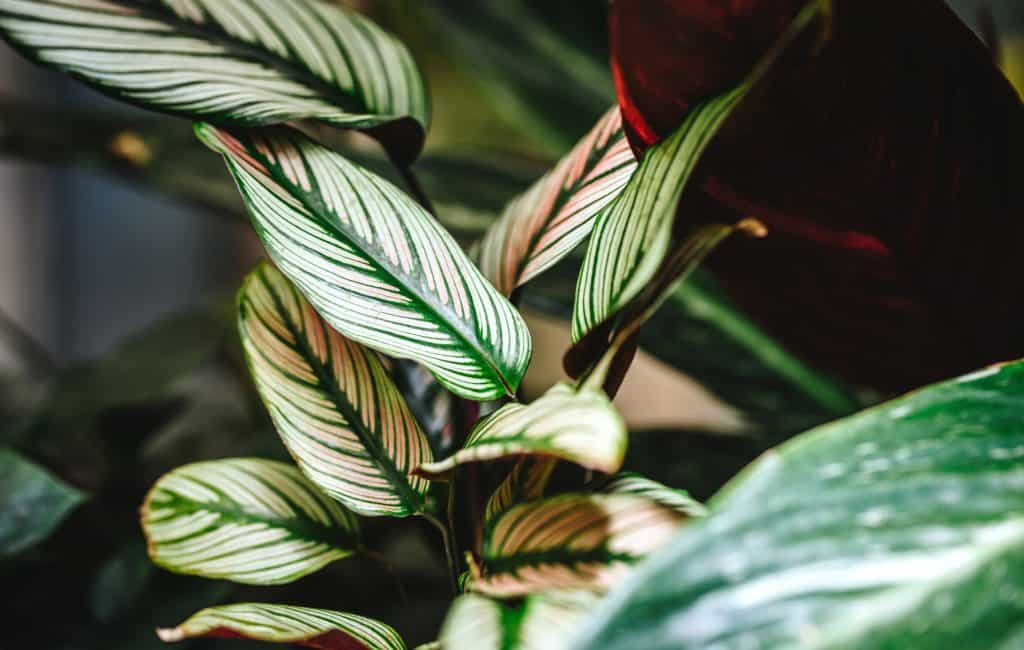The Calathea White Star is a tropical evergreen plant native to rainforests in South America, specifically Brazil, Ecuador, Peru, Bolivia, and Columbia. The Calathea White Star is known for having dark green tapered leaves that feature uniformed white stripes reaching from the center to the edges of each leaf with deep burgundy undersides and stems. This beautiful Calathea also develops a pink hue as the plant ages. Not only is the White Star a gorgeous plant to keep but it also has the added benefit of having air-purifying qualities and will help filter toxins out of your home.
Calathea White Star Care
The Calathea White Star has very specific care requirements and is generally difficult to maintain. While most plant keepers agree that the magnificent coloration and mesmerizing movement of the Calathea White Star is very rewarding, it can be very challenging to care for.
Lighting
The Calathea White Star needs low to medium indirect sunlight. This plant is native to rainforests that provide an abundance of filtered light, therefore keeping your Calathea in partial shade is ideal. Exposure to some morning sun is fine, but overall, this plant should be kept out of direct sunlight to prevent any burning on the leaves. If your Calathea is outside, you should keep it in a sunny but shaded spot. If you opt to keep the plant indoors, place it a few feet from your light source. The Calathea requires 6 hours of filtered sunlight, or alternatively 8 hours using an artificial grow light. The wide leaves of the Calathea can collect dust over time, inhibiting light absorption, so make sure you are regularly checking and cleaning the leaves of this plant.

Soil Type and pH
Calathea White Star soil requirements are very particular. The White Star should be placed in a loose high-nutrient soil blend. This Calathea also requires soil that is very well-draining but can retain enough moisture to keep the plant hydrated. Using fast draining soil is crucial in providing proper care to this plant. You can use a standard potting mix and add other ingredients to create these specific soil conditions. Adding 20% orchid bark is a great choice in this soil blend as it will aid drainage while also helping to retain extra moisture in the soil. Alternatively, you may use 20% peat moss which will assist with moisture retention while also adding organic matter to create more nutrient dense soil. However, peat moss tends to be acidic and too much can result in improper pH levels for your Calathea. Including 10% perlite in your soil blend will increase drainage and provide proper aeration. You may also include 10% activated charcoal to prevent root rot and repel insects. The Calathea prefers slightly acidic soil so ensure your soils pH level remains around 6.5.
Watering Requirement
The Calathea White Star watering requirements is another area of care that can be tricky. The Calathea needs to be kept in damp soil but should not be overwatered or waterlogged as this plant is very susceptible to root rot. A specific watering routine will be different for each specific plant, depending upon size, soil conditions, humidity levels, temperature, etc. The White Star will need to be watered more regularly during its growing season from April to September, while waterings should be reduced in the wintertime when the soil takes longer to dry. Generally, it is recommended to water about once a week during the growing season and about once every two weeks in winter. However, observing your plant is the best practice in creating an efficient watering routine. Check the plant regularly and if the top 2 inches of soil are dry it is time for another watering. The Calathea can be sensitive to chemicals in tap water, which can cause leaf discoloration or burns, so using distilled or filtered water kept at room temperature is best for this plant.
Humidity Requirement
Calathea White Stars love a very humid environment and should be kept at a minimum of 50% humidity, although 60% or higher is ideal for this plant. If their environment has lower humidity than 50% it is recommended to provide extra care to help mimic the humid tropical conditions they require. Some of the steps you can take include keeping a humidifier with the plant, using a watering tray with pebbles to avoid waterlogging the roots, or keeping a bowl of water next to the plant so the water can evaporate into the air. You can also mist the plant twice a week in the morning so that the leaves have time to dry or keep this plant with any other plants in your home where it will be more humid.

Temperature
The Calathea White Star thrives in tropical temperatures of 65°F to 80°F (18°C to 27°C). This plant can withstand temperatures up to 90°F (32°C) but should not be exposed to these temperatures for prolonged periods. Temperatures below 60°F (15°C) can cause the Calathea to go dormant to reserve energy. This plant cannot withstand freezing temperatures or frost and should be brought indoors during winter if you will experience these conditions where you live. The White Star will stop praying when temperatures are too cold.
Hardiness Zone
The Calathea White Star is native to South America hardiness zones 12 and 13 but can be grown outdoors in North America zones 9 and 10. Other parts of the United States should keep the Calathea as an indoor plant since it should not be exposed to their winter temperatures.
Fertilization
Fertilizing your Calathea White Star can promote more vibrant coloration on the leaves, however since this plant prefers high-nutrient soil they do not require excessive fertilization. If you do choose to fertilize your Calathea, do so only once a month during the growing season in spring and summer. The White Star is sensitive to salts and chemicals in fertilizer and therefore ensure you are using a diluted slow release and water-soluble fertilizer for this plant.
Propagation
Calathea White Star propagation can be accomplished through root division while repotting. This should be done during the growing season. Use small pots with drainage holes and partially fill with a soil blend that is suitable for a Calathea. Remove the mother plant from its current pot and gently separate the roots, washing the soil from them if needed. Make sure to keep the root bulbs intact and cut off sections of healthy roots to repot into your prepared containers. Once root cuttings have been moved into the separate pots, cover them with more soil and water immediately, ensuring that the soil is draining well. Keep the new cuttings in a spot that receives bright indirect light and provide with regular care. Be patient with your new plants, as the rooting and growth process can take a long time. Be sure to use care during the propagation process so as not to damage the fragile roots of the Calathea or cause stress to the plant.
Size & Growth Rate
The Calathea White Stars growth rate will depend on the care and conditions provided for the plant. Most of this plant’s growth will occur during spring and summer, and growth will slow down in the winter. This plant can grow up to 4 or 5 feet high and 1 to 2 feet wide.
Common Problems Growing Calathea White Star
Improper care of your Calathea White Star may lead to issues, infestations, or poor health. Here is a breakdown of common problems that may occur while caring for your Calathea:
- Leaves that have brown edges may be due to low humidity or from the use of tap water during plant waterings. Ensure that you are using filtered water and that your Calatheas environment has at least 50% humidity.
- Leaves turning yellow typically occurs from overwatering. To treat this issue cut off any wilted yellow leaves and make certain you are using a proper soil blend that is draining efficiently. Allow the soil to dry out before your next watering.
- Curling leaves indicate that temperatures are too low for your White Star. Increase the temperature in its current location or find a new and warmer spot for the plant.
- Drooping leaves are a sign of underwatering. Check the soil and, if completely dry, water your Calathea immediately and check the plant again in a few days.
- Root rot is common plant disease that may affect your Calathea so be sure to use well-draining soil for this plant and check the roots for soft and brown spots if the plant begins to exhibit signs of poor health.
- Brown spots on the underside of your Calathea leaves is a sign of rust fungus, a fungal disease caused by overwatering, lack of aeration, or too much light. To treat this fungus, prune all affected leaves and use a fungicidal spray on your plant.
- Some of the common pests you could find on this plant include spider mites, aphids, and mealy bugs. To prevent infestations, regularly inspect the leaves and stems of your Calathea and spray with neem oil or an organic pesticide. If pests are found, isolate the plant, and treat it with insecticidal soap. You may have to provide multiple treatments to your Calathea after an infestation.
How to Repot Calathea White Star
Calathea White Stars will typically need to be repotted once every two years, although the growth rate of your specific plant may cause this to vary. Calatheas tend to enjoy a somewhat rootbound existence therefore you can wait to repot this plant until you see roots coming out of the drainage holes. When repotting, use a pot that is one size larger than its current pot and use fresh soil. A pot that is too large increases the chance of overwatering and causing root rot for your White Star.
Do Calathea White Star Flower?
The Calathea White Star does not flower, however the rich contrasting colors and striking variegation make this plant a beauty to have around regardless.
Do Calathea White Star Move at Night?
Calathea White Stars are known as praying plants, meaning their leaves fold upward and close, resembling praying hands. This occurs at night to conserve water and the leaves will reopen in the daytime.
Are Calathea White Star Safe for Pets?
The Calathea White Star is not toxic to cats, dogs, or humans, making this a safe option to keep indoors.
Where Can I Find Calathea White Star for Sale?
Calathea White Stars is relatively easy to find and can be purchased in locally owned or chain gardening stores, as well as online from Etsy or other plant selling websites. The price for a White Star will typically range from $15 to $40.
